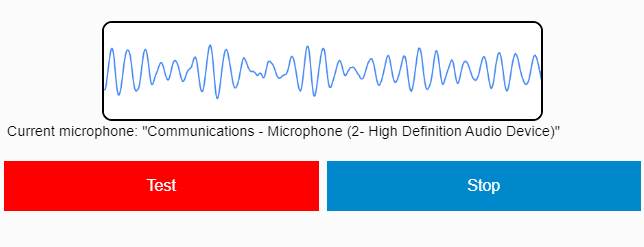MIC TEST
Use this online mic test tool to check and test the working of your microphone
Anweisungen (Für Mikrofontest):
- Drücke den 'Prüfung' Taste.
- Klicken Sie auf "Zulassen", wenn im Browser eine Frage angezeigt wird.
- Jetzt sollte sich die Linie bewegen, während Sie durch Ihr Mikrofon sprechen!
Wenn die Leitung auf Geräusche reagiert, bedeutet dies, dass das Mikrofon funktioniert!
How our Microphone Testing Tool is Safe to Use?- (Your Privacy Is Very Important To Us)
Unser Mikrofon-Testtool basiert auf Datenschutz, d. h „Kundenseite“ – Dies bedeutet, dass das Mikrofontestteam Ihre verschiedenen Stimmen oder andere Arten von Informationen nicht aufzeichnet und auch nicht aufzeichnen kann.
Having Trouble with using our microphone testing tool? Read Further to properly test your microphone.
Können Sie mit diesem Tool keinen Mikrofontest online durchführen? Hier ist eine Schritt-für-Schritt-Anleitung, die Ihnen hilft, den Mikrofontest einfach durchzuführen.
* Wenn Sie die Mikrofontest-Site zum ersten Mal oder nach dem Löschen Ihres Verlaufs besucht haben, werden Sie von Ihrem Browser aufgefordert, dieser Site den Zugriff auf Ihr Mikrofon zu erlauben. Wählen Sie Zulassen, um einen Online-Mikrofontest durchzuführen.
* Wenn Sie einen PC / Laptop haben, sollte diese Frage ganz in der Nähe der Adressleiste oben auf Ihrem Bildschirm stehen.
* Nun, wenn Sie ein mobiles Gerät haben, scrollen Sie ganz nach oben. Es wird angezeigt, auszuwählen Erlauben.
* Versuchen Sie nun, etwas in Ihr Mikrofon zu sagen, damit unser Tool den Mikrofontest durchführen kann. Sie sollten dann in der Lage sein, eine Linie zu sehen, die sich im Bereich der Testbox nach oben und unten bewegt, wenn Ihr Mikrofon einen Ton hört, etwa so:

* Wenn Sie beim Sprechen oder Sprechen in Ihr Mikrofon sehen, dass sich eine Linie nach oben und unten bewegt, ist Ihr Online-Mikrofontest erfolgreich. Ihr Mikrofon ist richtig konfiguriert.
Anleitung zur Fehlerbehebung bei Mikrofontests
Wenn Sie nach dem Zugriff auf Ihr Mikrofon keine Leitung sehen können, versuchen Sie die folgenden Schritte:
Schritt 1. In einigen Fällen sehen Sie beim Testen Ihres Mikrofons keine Linie. Sprechen Sie in diesem Fall relativ lauter in das Mikrofon und sehen Sie, ob die Linie erscheint.
Schritt 2. Aktualisieren Sie die Seite und versuchen Sie es erneut. In den meisten Fällen behebt es das Problem.
Schritt 3. Wenn Sie nicht wissen, ob Ihr Mikrofon funktioniert, nachdem Sie die beiden oben aufgeführten Schritte ausgeführt haben, überprüfen Sie bitte, ob Ihr Mikrofon richtig an Ihr Gerät angeschlossen ist.
Wenn Sie eine Leitung sehen können, sich die Leitung jedoch nicht bewegt, ist Ihr Mikrofon entweder defekt oder nicht richtig eingerichtet (mehr Chancen).
Versuchen Sie diese Schritte, um das Problem zu lösen:
Schritt 1. Wenn Sie Safari als Webbrowser verwenden, sollten Sie diese Mikrofontest-Website in einem anderen Browser wie Google Chrome oder Microsoft Edge öffnen.
Schritt 2. Stellen Sie als nächstes sicher, dass Ihr Mikrofon an die richtige (normalerweise rosa) Buchse Ihres Laptops/Computers angeschlossen ist. Wenn es sich um ein Mikrofon mit USB-Anschluss handelt, prüfen Sie, ob es sich um eine richtig angeschlossene USB-Buchse handelt (Bitte verwenden Sie in diesem Fall nicht das rosa Mikrofon).
Schritt 3. Stellen Sie als Nächstes sicher, dass Ihr Mikrofon nicht stummgeschaltet ist.
Schritt 4. Stellen Sie zu guter Letzt sicher, dass die Lautstärke am Mikrofon aufgedreht ist.
Sie haben versucht, den Mikrofontest online durchzuführen und Ihr Mikrofon funktioniert immer noch nicht? Hier sind einige Lösungen für Sie:
Funktioniert Ihr Windows 7 oder Windows 10 Mikrofon nicht? Nun, Sie können Ihre Mikrofoneinstellungen in Ihrem Betriebssystem problemlos beheben und Ihr Mikrofon funktioniert einwandfrei.
So ändern Sie die Mikrofoneinstellungen in Windows 10
So ändern Sie die Mikrofoneinstellungen in macOS
So ändern Sie die Mikrofoneinstellungen in Windows 8
So ändern Sie die Mikrofoneinstellungen in Windows 7
So ändern Sie die Mikrofoneinstellungen in Ubuntu (Linux)
Erfahren Sie mehr über den Online-Mikrofontest
Welchen Vorteil hat die Durchführung des Online-Mikrofontests über diese Site?
Wenn Sie Anwendungen wie Skype oder Discord verwenden, ist deren Mikrofontestfunktion möglicherweise nicht hilfreich und Sie wissen möglicherweise nicht, ob Ihr Mikrofon funktioniert. Diese Anwendungen sind für unterschiedliche Zwecke konzipiert und konnten daher den Mikrofontest nicht gut bestehen.
Mit unserem Online-Mikrofontest-Tool können Sie Ihr Mikrofon jedoch in Sekundenschnelle testen, um Probleme mit der Mikrofonverbindung sofort auszuschließen.
Was ist das Problem beim Mikrofontest mit Software?
Das Problem beim Testen Ihres Mikrofons mit einer Software, die Ihr Mikrofon scheinbar nicht hört, besteht darin, dass Sie nicht sicher sein können, ob das Problem in der Software oder Ihrem Mikrofon liegt.
Was soll ich tun, wenn mein Mikrofon in manchen Softwareprogrammen nicht funktioniert?
Wenn Sie den Online-Mikrofontest auf dieser Website durchführen konnten und festgestellt haben, dass Ihr Mikrofon funktioniert, es aber immer noch Probleme mit Software von Drittanbietern verursacht, empfehlen wir Ihnen, sich an das Support-Team dieser Software zu wenden.
Stellen Sie sicher, dass Sie ihnen auf themictest.com mitteilen, dass Ihr Mikrofon einwandfrei funktioniert, damit Ihr Problem schnell behoben wird.
Du kannst auch teste deine Webcam wenn Sie Anwendungen wie Skype verwenden, die auf Videoaufzeichnungen basieren.
Auf der Suche nach dem besten Mikrofon für Discord - Klicke hier.
Die teuersten Mikrofone in Ihren Gadgets oder nicht? Sehen Sie sich hier die 7 teuersten Mikrofone der Welt an
